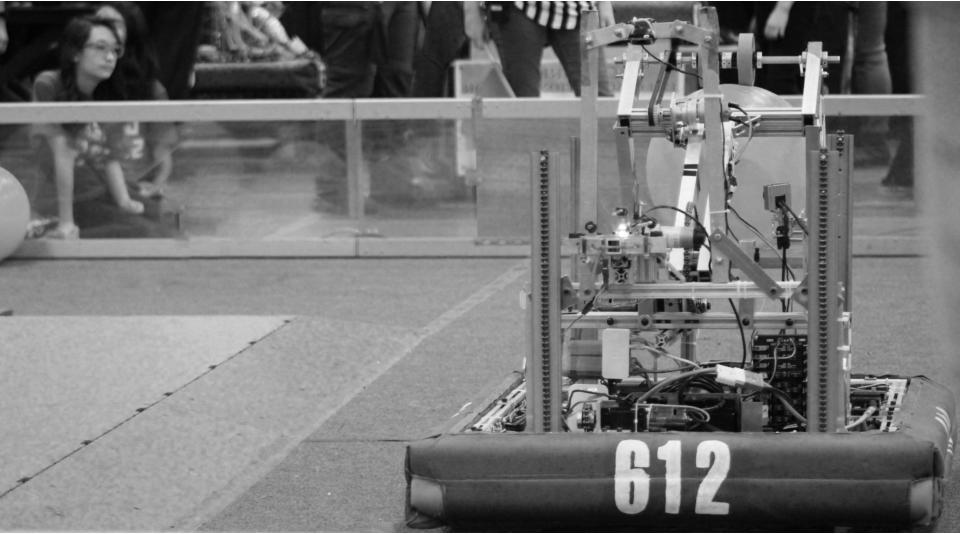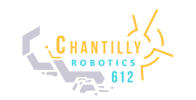
SIX-WHAT?
In 2012, Dean Kamen gave FIRST teams one mission: Make It Loud. In the past we have struggled to accomplish this mission, doing little to use
our voice constructively. This is no longer the case. Over the past five years, we have transformed ourselves beyond recognition. We have not
only built better robots, but have created a greater impact on our team and community as a whole.
Mistakes Made
This transformative process began during the 2017 season. We won the first district event in our team’s history, as well as a District Chairman’s
Award. Yet, these successes only masked deeper problems. With over 100 members, we were loud but disorganized. During the build season,
our leadership was determined to see only their designs implemented. Consequently, other members had little opportunity to provide input and
collaborate. These issues contributed to a robot that had few successes and deep design flaws stemming from the limited number of
contributors. We knew our team wasn’t where we wanted it to be and had to change.
Lessons Learned
Our mentors addressed our team’s issues by hosting ‘Lessons Learned,’ a workshop where the entire team reflected on what worked well
and what we should improve. Each member wrote their comments on sticky notes, which were then grouped together and reviewed
individually. This was the first time in recent history where each member was able to actively contribute to the direction of the team. ‘Lessons
Learned’ pointed out problems with our decision-making process, communication, and inclusivity. We analyzed each issue and settled on a plan;
our efforts to grow together began to be put into action.
Start of a New Era
In the 2018 preseason, we put our conclusions from ‘Lessons Learned’ to good use. We engaged students by creating curricula for two of
our subteams, formed and taught by both students and mentors. This partnership became essential to the strength of our team. Mentors
offered their expertise by guiding lessons and advising leadership. The number of captain positions expanded to ensure that experienced
students had a stable platform to teach others. In doing so, students had greater influence on the team’s direction. However, without a proper
stream of communication, we could not function well. To solve this issue, we expanded our usage of Slack, a team-based messaging service.
While we were first introduced to Slack the previous year, we fully implemented it into our team structure to ensure everyone was informed on
developments in the team. Overall, these reforms allowed our team to be cohesive, laying the foundation for a remarkable build season.
At 2018’s kickoff, members formed groups to design and present competing build strategies. Through this method, every member had a say in
how the robot would be built. Mentors and leadership then assembled a rubric to grade and critically analyze each robot design. It presented
questions on robot assembly. How easy is the robot to build? Does the robot have a clear strategy? How much would the robot cost? By asking
these questions, we ended up with a robot that took us to the World Championship. The improvements we made to our team were reflected in
our new robot’s performance. With the whole team engaged and giving input, we had perspective and ideas that previous methods would not
have yielded.
Shining a Light
Students of our team asked for another ‘Lessons Learned’ at the end of the 2018 season. Instead of only discussing what we could
improve, we dug deeper, critically examining our team’s values and collective identity. We devised a new code of conduct with proper
communication as a cornerstone. We also made a mission statement: “to brighten the future for leaders and student technologists within our
team, school, and community through fun and engaging methods of learning and teaching, while shining a light on the importance of STEM.” The
code of conduct and mission statement both provided a way to unify all the voices in our now 120+ member team and serve as a blueprint for
the future.
Creating Leaders and Student Technologists
Our renewed mission and strengthened infrastructure not only made our team more unified and efficient; it also enabled our members to
seize opportunities we never could have dreamed of in our previous seasons. The positive experience that we imparted on our members
resonated with them as alumni. In a recent survey of our alumni, 77% of participants said they are pursuing a STEM career. Through our
reforms, we were able to inspire our current members to find new purpose in their lives.
Even within our team, we are encouraging new ventures. After our 2019 kickoff session, members and mentors of our team had a radical
idea for our robot: use soft robotics in order to grip game pieces. Soft robotics is a field of robotics where the parts are flexible. We decided to
try it, despite it never having been used on an FRC robot. Although we were able to create a functioning mechanism, we realized that it was
unreliable and that a traditional intake would be better suited for the job. Due to the rubric we established the previous year, all team members
were respectful and understanding of this decision. Yet, we knew that we did not have to end our work there. We decided to create an
innovation page on our website to curate our research and development process to assist other teams interested in using soft robotics in the
future. In 2017, we were not organized enough to explore such a radical field of robotics and consciously choose to reject it. Yet, with our
growth over the past few years, we went from a team unsure of its own identity to a team willing to assert itself and facilitate new ideas and
research.
Embodying FIRST Values
Focusing our mission to shine a light on the importance of STEM has also improved our outreach program. One example of this is the FLL
Qualifying Tournament that we have hosted annually for over a decade. While this has always been a staple of our outreach program, our
newfound unity behind our mission led to better organization of the event. Over 50 team members filled almost every role possible, from
judge’s assistant to scorekeeper. As a result, we had 28 teams sign up, filling up our tournament registration on day one. This success had an
even greater result: we inspired over 300 participating students and parents to explore STEM while having fun.
This year, we went beyond FLL to create an FRC Rookie Assist program. We assisted Cadet Robotics, Generals Robotics, C-Hawks, and
Chrysaora Robotics—inexperienced FRC teams and FTC teams looking to transition into FRC—by advising them on engineering, marketing,
financing, and other aspects of FRC. Through the Rookie Assist program, we helped teams build confidence to start their season
well—encouraging the students who run them to continue on with STEM in the future.
Brightening the Future for Our Community
Our dedication to spreading STEM through fun and engaging methods led us to Rocky Run Middle School, Hutchison Elementary School, and
Brookfield Elementary School. The last two are Title 1 Schools, where students have limited opportunities to pursue STEM. To help these
students, we started LEGO clubs at both Rocky Run and Brookfield in 2016 and 2018 respectively. Team members built curricula around LEGO
Mindstorms projects and past FLL challenges. These clubs gave students a chance to experience and gain interest in STEM. We expanded this
initiative with a STEM summer camp at Hutchison Elementary School in 2017 and Brookfield Elementary School in 2019, inspiring more
students to explore STEM and imagine new possibilities. With our newfound focus and mission, we were able to improve the way we presented
ourselves and FIRST.
Elevating FIRST and STEM Nationally
Another highlight of the impact of our development over the years is our participation at the Defense Manufacturing Conference (DMC). DMC
is a national conference showcasing technology, with over 1,750 participants and 650 participating organizations including industry-leading
companies in the STEM field such as GE, Raytheon, and Boeing.
We first participated in DMC in 2017, when we took the initiative to contact FIRST, the DMC organizers, and later local FLL, FTC, and FRC
teams to assist in the event. We took DMC to the next level in 2019 by proactively partnering with Arizona FIRST and local teams to amplify our
presence and voice. Overall, the event garnered the most traffic of any event hosted by FIRST HQ and attracted dignitaries such as the
Department of Commerce Director for Advanced Manufacturing and a Deputy Undersecretary of Defense. DMC is one of the most important
events in our team’s history; it shows how far we’ve been able to reach outside our own community to spread the mission of FIRST and to
prepare the next generation of student technologists and leaders.
SIX-TWELVE!
In 2012, Dean Kamen gave one mission to FIRST teams: Make It Loud. We have now reached a point where we wholeheartedly embody
this statement. Evidence of this can be found in our performance last year. Due to our commitment to introspection and improvement since
2017, our team has become more cohesive than ever. Hours of teaching, strategizing, and prototyping paid off in the 2019 season with the
creation of a robot that led us to victory in both our District Qualifiers for the first time in our team’s 20-year history and placed us first in the
Chesapeake District prior to District Championships.
In 2017, we were unsure of our identity amidst a mass of confused members vying for attention. Now, we are a 120+ member strong team that
not only consistently makes quality robots but acts as a staple of FIRST in our community. Our struggle throughout the past 5 years has fueled
our resolve and made us stronger. With the learning and experience we gained, we are poised to make it louder than ever before.



















